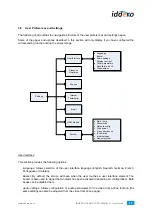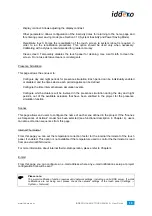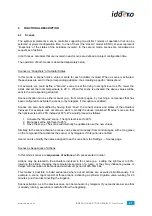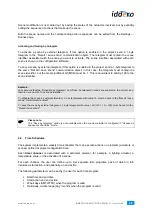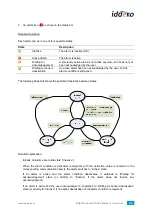
www.iddero.com
IDDERO HCx-KNX TOUCH PANELS – User Guide
23
The “Week days” field can be used to specify which days of the week the program should apply to.
The start and end dates make it possible to limit the weekly schedule to a specific period of the year.
For example, users could define a program that would only run on weekends during the months of
June, July, and August.
)
Please note:
The system assumes that the end time always comes after the start time, even if this implies that the
end action will be run on a different day than the start action. Week day and date range checks are
always done for the start action. If the start action should be run, it is assumed that the end action
should also be run.
Example:
Consider the following case:
A time program is configured including a start action and an end action
Start time is set to 22:00, and end time to 03:00
The “Week days” is set to Fridays.
No start or end dates are defined
Resulting behaviour will be as follows:
1. The start action will run at 22:00 on Friday.
2. Since the system assumes that the end time always comes after the start time, it considers that the end
time in this case refers to the early hours of the next day, i.e. Saturday 03:00am.
3. The end action will then run on Saturday at 03:00am, even though Saturday was not included in the
“Week days” field. This is because the week days and date range checks are always done for the start
action, and the result of these validity checks is automatically applied to the end action as well.
On the other hand, note that if the start time is set to 03:00 and the end time to 22:00, both actions will be run on
the same day (Friday).
Each timer channel can be enabled or disabled either manually (from the screen or through the web
interface) or by telegram, if this option is set in the project.
4.3 Alarms
The alarm subsystem allows for monitoring and management of external alarm events, such as fire,
flood, or gas leak alarms.
Alarms can be configured to require (or not) acknowledgement by the user, either manually or by an
external telegram. It is also possible to specify whether an explicit alarm deactivation (reception of a
telegram showing that the alarm condition is no longer active) is required.
For alarms requiring explicit deactivation, it is possible to configure whether the alarm should be re-
triggered automatically if a certain time elapses after the user acknowledged the alarm and the alarm
deactivation telegram has not been yet received
Alarm Triggering
If any of the configured alarms is triggered, the system enters the alarm state and performs the
following actions:
1. The LED status indicator on the front panel turns red
2. A warning beep sounds (depending on configuration)









